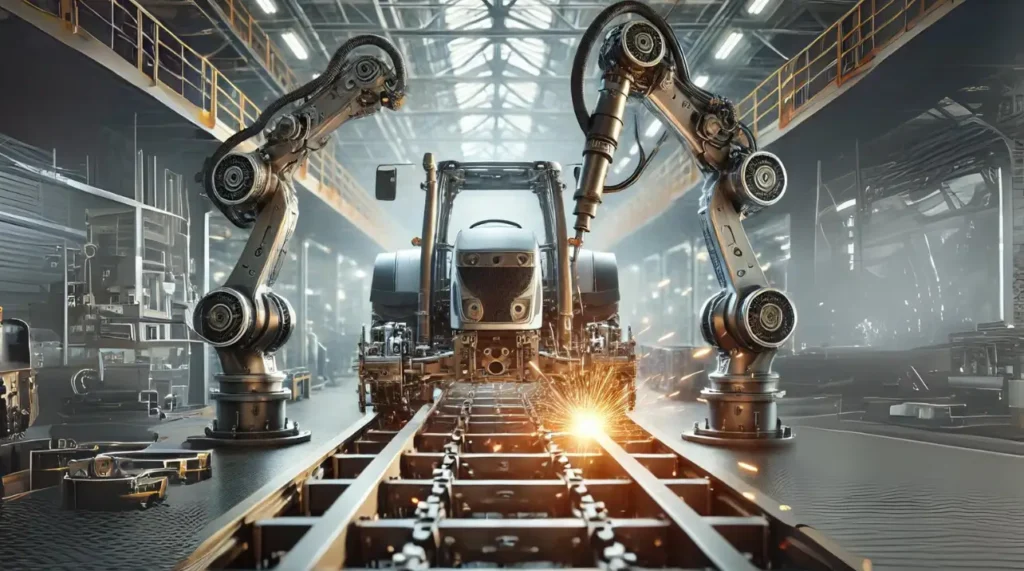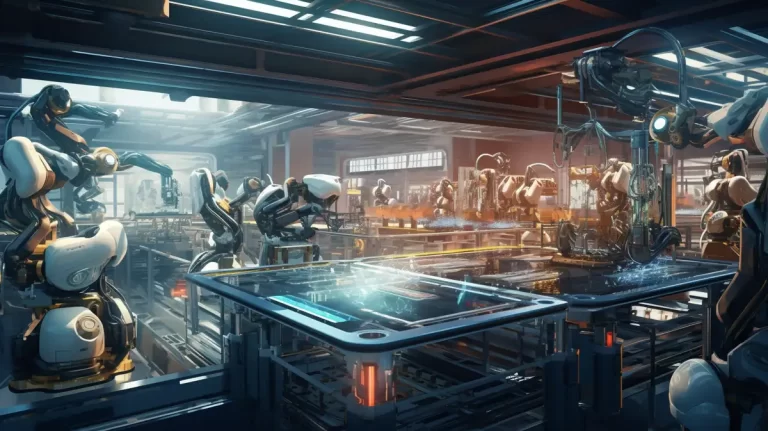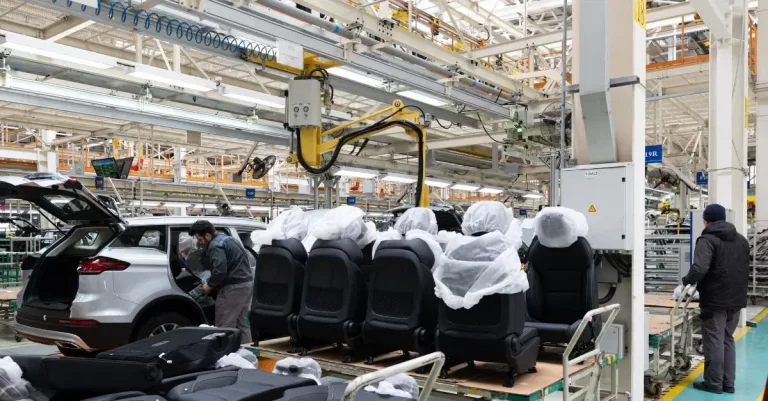AI in tractor and combine harvester assembly Inspection is one of the key innovations driving change in the agricultural machinery industry. In recent years, farmers have come to rely on dependable machinery, like tractors and harvesters, to boost productivity. To ensure these machines are built accurately, manufacturers are adopting advanced technology.
The role of AI in tractor and harvester assembly inspection is becoming crucial. By improving quality control, AI technology helps make these machines more reliable. By improving quality control, AI technology helps make tractors and harvesters more reliable. This article will explain how AI is changing the inspection of tractors and harvesters during assembly. It will also cover why this change matters and the benefits it brings.
Key Takeaways:
- Enhanced Defect Detection: AI detects porosity and other defects during welding. This improves reliability in tractors and combine harvesters.
- Advanced Algorithm Use: Techniques like WOA and LSSVM are employed. These improve defect detection accuracy to as high as 90.5%.
- Welding Process Efficiency: AI detects welding defects in real-time. This ensures high-quality welds and fewer assembly delays.
- Real-Time Corrections: The collaboration between Intel and John Deere allows AI systems to correct defects instantly. This reduces waste and improves line efficiency.
- Adaptability in Harsh Environments: AI-based inspection tools are used directly on welding torches. This allows inspections even in harsh environments, such as those with high heat and sparks.
What is AI Assembly Inspection?
AI assembly inspection uses artificial intelligence to check products during the manufacturing process. It ensures each part meets required quality standards. AI systems use computer vision and machine learning to find even the smallest defects. These systems are far more precise than human inspectors.
AI in Tractor and Combine Harvester Assembly Inspection helps manufacturers catch flaws that might otherwise be missed by traditional methods. For tractors and harvesters, this means better reliability. It also reduces the chances of faulty parts getting into the market. AI in Tractor and Harvester Assembly Inspection helps manufacturers make better equipment. This, in turn, means fewer breakdowns for farmers.

The Need for AI in Tractor and combine Harvester Assembly inspection
Tractors and harvesters have complex designs. They contain thousands of parts that must be perfectly assembled. Even a small defect in one part can lead to major issues.
Traditional methods of inspecting these parts involve manual inspection. But manual inspection has its limits. Human eyes can miss small defects, especially after hours of work. This is where AI in tractor assembly inspection becomes vital.
AI systems do not get tired. They do not lose focus. They can inspect parts and assemblies faster. They do so with more accuracy than human workers. AI systems also store data.
This means manufacturers can analyze trends and predict issues before they become big problems. AI adds a layer of reliability that traditional inspection methods cannot match.
How Does AI in Assembly Inspection Work?
AI inspection works by using sensors and cameras to capture images of parts in real-time. These images are then analyzed by machine learning algorithms. The system can compare each part against the ideal standard. Any deviations are flagged instantly. In combine harvester assembly, for example, each component is inspected by the AI system.
AI in Tractor and Combine Harvester Assembly Inspection allows for detailed inspection of each part, ensuring that all components are correctly aligned and meet specifications. Then it is being compared to models in its database. If a part is misaligned, cracked, or does not meet specifications, it is flagged. This allows for corrections before final assembly. This saves costs and ensures better performance.
By using AI in Tractor and Combine Harvester Assembly Inspection, manufacturers can quickly adjust and correct defects, preventing future issues and saving costs. AI in combine harvester assembly inspection also benefits from deep learning. This allows the AI system to improve its accuracy over time. The more parts it inspects, the better it becomes at finding defects.
Recent research shows that improved Whale Optimization Algorithms (WOA) combined with Least Squares Support Vector Machines (LSSVM) have been used to enhance quality inspection for combine harvesters. This technique focuses on optimizing parameters to increase defect detection accuracy. It has reached up to 90.5%. This high accuracy rate improves the reliability of combine harvester assembly inspection.

Benefits of AI in Tractor and Harvester Assembly Inspection
1. Enhanced Precision
AI systems can detect tiny defects that humans often overlook. This ensures that every part meets the highest standards. Farmers depend on these machines for their livelihoods. By increasing precision, manufacturers deliver equipment that is more trustworthy.
AI systems using algorithms like the improved WOA are effective in finding defects during the manufacturing process. These optimized models lead to greater accuracy in finding even minor issues.
2. Cost Reduction
Finding defects early in the assembly process can save a lot of money. Reworking or recalling faulty machinery can be very expensive. AI minimizes the chances of these issues.
AI systems use advanced algorithms to detect faults early. They apply signal analysis techniques to identify problems before they grow, reducing the cost of rework or replacements.
3. Increased Speed
Manual inspection takes a lot of time. AI can check components much faster. This means manufacturers can produce machinery more quickly without compromising on quality.
By automating quality control with advanced AI models, including deep learning and optimization algorithms, inspections are completed faster.
These systems classify faults much quicker compared to traditional manual inspections. Using AI and computer vision integrated into assembly tools, such as welding torches, allows inspections to happen in real-time.
For example, Intel’s collaboration with John Deere has shown how AI can increase the speed of welding inspections, ensuring that issues are fixed right away and assembly lines continue running smoothly.
4. Data-Driven Insights
AI systems collect data. This data helps identify recurring issues in assembly lines. Manufacturers can adjust the process to prevent these problems in the future. This makes AI in tractor assembly inspection a tool for both quality and continuous improvement.
Techniques like Local Mean Decomposition (LMD) for signal processing work with AI to extract key features of faults. This gives manufacturers insights into recurring issues. It also helps improve quality control strategies.
Intel’s collaboration with John Deere shows the benefits of AI in real-time defect detection because it identifies problems as they occur, allowing for immediate corrections. This proactive approach helps maintain quality and boosts operational efficiency.
5. 24/7 Operations
AI does not get tired. Unlike human inspectors, it can work 24/7. This allows inspection processes to run without pauses. This leads to faster production.
Using AI-enhanced welding robots shows how 24/7 work can be achieved. By combining human skills with AI, these robots maintain consistent quality, ensuring that production lines stay efficient.

Real-World Application: Improved Inspection with Advanced AI Techniques
An example of AI in combine harvester assembly is the use of an improved Whale Optimization Algorithm (IWOA) combined with LSSVM. This model optimizes quality inspection by improving accuracy.
It also avoids local optimum issues found in earlier models. It has been tested on the Dongfanghong 4LZ-9A2 combine harvester, showing increased reliability in the assembly inspection process.
Similarly, John Deere’s collaboration with Intel shows how AI can improve weld quality. This is especially true in harsh environments where traditional inspections often fail. Using adaptive algorithms, the system adjusts to changing production environments.
It balances both local and global optimization during fault detection. This allows manufacturers to fix faults during assembly and meet strict quality requirements.
The Future of AI in Agricultural Machinery Assembly
As AI evolves, we can expect more advancements in agricultural machinery inspection. AI in Tractor and Combine Harvester Assembly Inspection will continue to innovate, allowing for more refined and effective inspection practices.
AI systems will keep getting smarter as they learn from the data they collect. Predictive maintenance will likely be the next step. AI will not only inspect parts but also predict when they might fail.
AI in tractor and harvester assembly inspection will merge with other automation technologies. The combination of robotics, IoT (Internet of Things), and AI will further change manufacturing.
The John Deere-Intel partnership hints at the future of AI in assembly:
“Welding is a complicated process. This AI solution has the potential to help us produce our high-quality machines more efficiently than before. The introduction of new technology into manufacturing is opening up new opportunities and changing the way we think about some processes that haven’t changed in years.”
–Andy Benko, quality director, John Deere Construction & Forestry Division
Challenges to AI Adoption in Assembly Inspection
Despite its benefits, adopting AI in Tractor and Harvester Assembly Inspection comes with challenges. The initial investment in AI technology can be substantial. Smaller manufacturers may struggle with these costs. Integrating AI into traditional assembly lines can also be complex.
Another challenge is the need for skilled workers. Operating and maintaining AI systems requires specialized skills. This means manufacturers need to invest in training. However, the long-term benefits of AI outweigh these challenges.
As technology advances, costs will go down. AI’s availability is already more wide spread then before, it will soon become accessible to all manufacturers, not just the big ones.
Conclusion
AI in Tractor and Harvester Assembly Inspection is transforming the agricultural machinery industry. It improves precision, cuts costs, and speeds up the inspection process. Manufacturers can ensure that their tractors and harvesters are of the best quality. Farmers, in turn, receive reliable machinery that boosts productivity.
The future of AI in assembly inspection is bright. AI in Tractor and Combine Harvester Assembly Inspection will continue to lead advancements, making processes faster and more reliable. The technology is evolving quickly. Soon, AI may take over other parts of manufacturing too. For now, it plays a key role in making sure tractors and harvesters are built to last.


